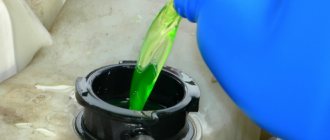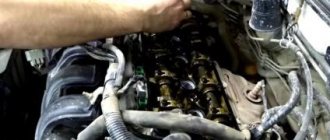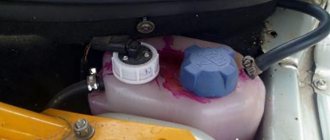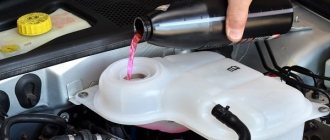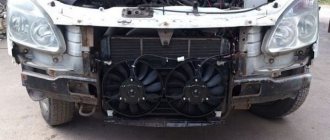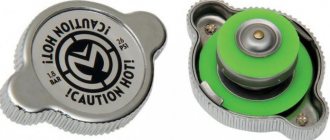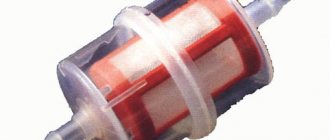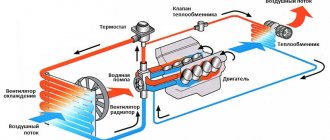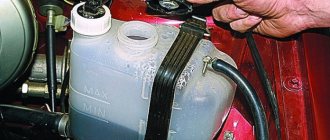Cooling system flush frequency
There are no clear rules written down anywhere. But you need to take into account that in a working car - a car, a truck, mixing of oil and antifreeze does not occur - the 2 fluids are sealed and function separately.
But sometimes oil gets into the cooling system (it’s a breakdown or the owner accidentally filled it in - it doesn’t matter) and you need to urgently take the necessary actions to fix the problem. If ignored, the situation will lead to the following consequences:
- wear of bearings, since parts are negatively affected by an aggressive environment;
- risk of diesel engine jamming, water penetrates the cylinders and causes water hammer;
- contamination of the main line and pipes of the cooling system, as a result of which the latter ceases to function.
What function does antifreeze perform?
First of all, it should be recalled that the word “antifreeze” has foreign roots and is translated as “anti-freeze.” This is how one can characterize its main function. This substance should not freeze even in very frosty winters.
In addition, the coolant performs the following work:
- fast and effective protection of the car engine from overheating during its operation;
- maintaining a high level of anti-corrosion protection for all existing metal parts;
- reliable protection of the cooling system from freezing when using the car in the frosty winter period.
Good to know: What is better to fill the cooling system with antifreeze or antifreeze?
Non-working cleaning methods
When faced with the problem of oil getting into the car’s cooling system, drivers at home resort to different cleaning methods. But not all options are effective.
For example, they clean with “Whiteness”. But few people know that the product contains chlorine, which causes corrosion of aluminum components (and the radiator of most cars is made of this metal). In addition, “Whiteness” is not capable of properly cleaning the system, but will only cause damage.
Another option is baking soda. It effectively removes rust and scale deposits, but cannot fight oily deposits.
Causes of pollution
Firstly, as can be seen from the above, a certain type of antifreeze can contribute to the formation of contamination inside the car’s cooling system.
Secondly, such a factor may be the use of sealant. When leaks appear in the engine radiator or heater, many people use this product to eliminate the leak. But the use of sealant is not as harmless as it seems; by sealing leaky areas, it can simultaneously clog the pipes and radiator cells.
Therefore, after applying the sealant, flushing the engine cooling system is mandatory. If flushing does not help, then manual cleaning of the pipes and radiator from sealant residues cannot be avoided.
Thirdly, cleaning and flushing yourself may be required after pouring low-quality liquid into the system. Impurities in it can easily clog pipes and radiators. Also, such a liquid can cause rust on metal elements, which does not contribute to the cleanliness of the system.
Another reason for flushing may be oil getting into the coolant. You can only wash it after the problem has been eliminated. This happens when the cylinder head gasket burns out or there is a crack in the block.
Effective folk remedies
There are also effective means, and many of them are available to almost everyone and are available in any home. But before using such methods, it is worth assessing the scale of the problem and, if possible, it is better to trust the specialists.
Milk serum
Whey is one of the effective folk methods. But some consider its effect exaggerated. However, the method is popular:
- Before use, the serum is filtered through a gauze bandage to remove existing sediment and clots.
- Liquid is added to the system and driven like this for 150-200 km. Some people simply warm up the engine and then drain the serum. If clots and oily deposits are observed, the procedure is repeated.
Coca Cola
Coca-Cola is not only a cooling drink. It is used to clean scale from dishes and electric kettles.
Many people recommend using Cola (or Sprite) as a cleanser against oil in the radiator. But you should be careful here, since this method of flushing the system is suitable for copper or brass parts. If a thin aluminum alloy is used, the liquid will not only not remove traces of oil, but will make holes in the walls and pipes, which will require repairs.
Lemon acid
To carry out cleaning you need:
- Dissolve 500-1000 g (depending on the contamination) of citric acid in 10 liters of water.
- Pour into the car radiator.
- Start the engine for 20-25 minutes.
- Disconnect and wait about 1 hour.
- Drain the dirty liquid and rinse with running water.
Fairy for dishes
Any detergent will do, but car enthusiasts recommend Fairy as the most effective and proven.
To clean the cooling system from oil deposits, you will need:
- Pour 200-250 ml of Fairy into water (the quantity is not important, it depends on the contamination of the system) and stir.
- Pour the resulting liquid into the expansion tank.
- Start the engine, wait for the filled liquid to boil, and then simply drain it. Repeat this until the system is cleared of oil, then rinse with running water until the foam completely disappears.
With this method, it is taken into account that Fairy produces a lot of foam. Therefore, when carrying out the procedure, it is worth monitoring the condition of the expansion tank.
Some drivers do not drain the solution, but try to drive 100-150 km this way. Afterwards, water is poured into the radiator and the system is completely cleaned.
Distilled water
Purified water is also considered an effective remedy if the purification procedure is carried out repeatedly.
So, how to flush the engine cooling system:
- Pour water into the expansion tank.
- Start the engine and heat the water to a temperature of 90°C.
- By pressing the gas pedal, the driver can observe how oil deposits are pushed out. This procedure is repeated 5-6 times, after which the system is considered cleared of contamination.
Debugg
We figured out why such a problem appears and what consequences it leads to. Now it remains to understand how to fix the breakdown and prevent it from reoccurring.
Eliminating engine oil is a complex, careful process that most often requires replacing the oil cooler gasket.
To carry out this manipulation you will need:
Oil in expansion tank
- distilled water (10 liters);
- antifreeze for replacement;
- container for draining spoiled coolant;
- oil cooler gasket. Do not try to clean the old one and return it to its original place: after interacting with unwanted chemicals, it has lost its properties;
- special detergent.
Because Oil appears in the cooling system of many vehicles; you can find special means to eliminate it in any auto store. Most importantly, do not try to purchase the cheapest product - it will not be able to completely remove oily liquid from the internal surfaces of the system.
The procedure for replacing the oil cooler gasket is quite simple: first you need to dilute the existing coolant with a detergent and let the engine run with this liquid for 10 minutes. Then you need to unscrew the drain plug of the cooling system and wait until it is completely empty.
After this, we install the oil cooler, clean it, and replace the gasket. Next, remove the expansion tank and thoroughly rinse it to remove any remaining oil.
Once all the manipulations are completed, you should assemble all the elements of the system and proceed with several flushes using distilled water.
If during these activities you notice cracks, chips in the parts and understand why oil is getting into the refrigerant, you should immediately replace the weak element to prevent re-mixing of the liquids.
To avoid such a problem, the driver should regularly maintain the vehicle and carefully check the condition of vital systems. If you doubt your own capabilities, then it is advisable to entrust the work to professionals. But under no circumstances should problems that arise be ignored.
Special means
When cleaning the cooling system from oil impurities, specially developed products are also used. Russian drivers have several effective options available to them.
ABRO AB-505 is considered popular. The drug fights limescale, rust, and removes oil stains well.
The full volume of liquid (standard 0.354 l) is poured into a system already filled with water. Start the engine for 30 minutes, with the car running at idle. Afterwards the engine is turned off and the liquid is removed. Then turn on the ignition again and, with the radiator drain hole open, constantly add water until the system is cleared of oil impurities and the water becomes clear.
An effective option is LIQUI MOLY Kuhlerreiniger. The developers assure that the product removes scale and various contaminants, including removing oil impurities. Additionally, the drug neutralizes acid and thick lubricants. And since there are no aggressive substances in the composition, it can be used with every fluid change. The product is also neutral towards plastic, rubber and metal.
To clean the tank of oil impurities, 1 package of the drug is diluted in 10 liters of antifreeze and poured into the radiator. Then they start the engine and wait 20-25 minutes. Turn off the engine, wait 3-4 hours and remove the contaminated antifreeze. The expansion tank is washed with running water. All that remains is to fill in the new solution.
Another effective product (sold in 2 bottles), according to reviews from car enthusiasts, is LAVR. The drug is designed to act in 2 stages, completely cleaning the cooling system. LAVR is capable of removing even heavy soiling.
The cleaning procedure is as follows:
- Antifreeze is completely removed from the cooling system; instead, a bottle is poured into the expansion tank to remove rust and scale. Afterwards, the system is filled to the minimum level with distilled (or at least boiled) water. Next, the engine starts and remains idling for half an hour (regardless of whether it is an automatic transmission or a manual transmission). Afterwards, the contaminated liquid is completely drained.
- Oil-emulsion deposit cleaner from 2 packages is poured into the empty radiator (after draining the liquid from 1 bottle). The system is filled with distilled water to the minimum level. Turn on the engine at idle speed for 30-40 minutes. At the end, the solution is drained, clean water is introduced into the system, the motor runs for another quarter of an hour, then the tap is opened to drain. This is repeated until clean, transparent liquid begins to flow from the tank. All that remains is to fill in new antifreeze.
Additionally, for minor contamination, drivers can use other flushing products from the LAVR line.
This includes:
- classic (Classic) liquid;
- for commercial vehicles (Fortrucks);
- synthetic (Syntetic) solution.
In addition, products from others are also offered: Bizol, Liquid Moly, Pingo. The preparations are tested, so they remove contaminants without harming the cooling system and its components.
How to flush the engine from emulsion, dirt and deposits
It is quite obvious that if you need to wash the engine from the inside, then you need a good engine flush. There are a large number of different formulations on sale.
In practice, all products can be divided into two groups:
However, choosing the best engine flush product is not so easy. First of all, you need to proceed from the specific situation. If you just need to flush the lubrication system before changing the oil, and we are not talking about removing remnants of an emulsion or counterfeit product, then a regular “five-minute” may be quite enough.
It should also be remembered that quick flushes in oil can also have a negative effect on gaskets, seals and other seals. There have been cases where, after applying oil flushes, the engine began to leak.
- In case of more serious contamination, it is better to use ready-made flushing oils, which are poured into the engine in full instead of base oil. Depending on the type of flushing composition, the unit should either operate only at idle speed, or short-term driving with minimal loads on the internal combustion engine is allowed.
This type of washing is less aggressive to rubber seals compared to “five-minute” ones, and also more thoroughly washes away dirt and deposits. We also note that flushing oils can be synthetic, semi-synthetic or mineral, and are also universal. In other words, they can be used in both gasoline and diesel internal combustion engines.
In practice, this solution can be considered optimal for flushing the engine from emulsion after antifreeze or antifreeze gets into the lubrication system. Flushing oils are also better suited for cleaning dirty internal combustion engines with high mileage.
At the same time, the risk of “clogging” the channels and filters (for example, in hydraulic compensators, the oil receiver mesh) with soggy dirt is still present, but it is not as high as compared to a quick rinse in engine oil.
Which way is better?
There are many ways to clean the system with your own hands, but none of them can be considered universal. It all depends on the contamination of the radiator with oil deposits and the material from which the expansion tank and other parts are made.
It is recommended to buy products at car dealerships or special places (for example, service stations). As for traditional methods, when using the same Coca-Cola, you cannot be sure of the quality of cleaning. In addition, if the radiator material is unknown or the person is inexperienced, then you may have to buy a new cooling system, including a thermostat.
For example, many carbonated drinks contain phosphoric acid. It easily corrodes the pipes, and this is an additional expense. It must be taken into account that you should work with any substance carefully, because even if you exclude the risk of damage to car parts, you can get burned yourself.
Experts pay attention to the point that even after cleaning the system with professional means and thorough rinsing, an oil film remains. The radiator is considered cleaned, but it is possible to completely get rid of contaminants and wash out the oil only if the tank is desoldered.
Therefore, despite the purchased preparations and cleaning methods, in case of severe contamination it is often advised to prepare for a complete replacement of all parts of the system. Only timely repairs and car care will keep your vehicle in good condition.
Flushes that do not work or are very dangerous for engine parts
If the substance used for cleaning is simply useless, then nothing bad will happen, even the deposits suspended in the liquid will be washed away. But the unpredictability of some foreign substances in the system can cause harm, often irreparable.
Plain water
Water is used for primary and final rinsing due to its cheapness and availability. It is advisable to use water with a minimum of mineral salts that form scale, as well as without acidic properties. Ideally, distilled, but it is not free. The replacement will be thawed or boiled.
Although many water supply systems have water of quite sufficient quality. It is not suitable for batteries, but will not harm the cooling system.
What can I use to wash it with?
There is now a wide range of cleaning products available. The most accessible of these is water. However, it is also the least suitable remedy. Due to the salts present in the water in a dissolved state, scale may form after washing, which in the future will cause contamination and repeated cleaning. For this reason, you should use only distilled or, as a last resort, boiled water.
Special cleaning fluids
The range of cleaning liquids of various compositions and concentrations is quite extensive. Most of them allow you to efficiently clean the engine cooling system. But the choice of product should also be taken seriously, since different types of dirt require substances of different compositions to remove.
Cleaning products can be divided into 4 categories:
- Neutral - do not contain aggressive components, are less effective in cleaning the cooling system than other liquids, and are most often used for preventive purposes.
- Acidic - almost never found in pure form due to their extreme aggressiveness to system parts. Acidic flushing fluids are well suited for neutralizing scale and inorganic deposits.
- Alkaline - like the previous category of substances, are not found in an undiluted state. Effectively removes organic contaminants.
- Two-component - contain both acid and alkali. They are consistently poured into the system and thoroughly clean it of all types of contamination.
Coolant racks
It is better not to use two different products at the same time, since the acid and alkali are neutralized during interaction, which may not only not bring the expected result, but also cause a malfunction. You should also not use substances with high concentrations of acids or alkalis, as they can damage rubber and plastic parts.
Lemon acid
One of the popular “improvised” cleaning agents is a solution of citric acid. If the correct proportions are observed, it copes well with scale inside the radiator and does not damage rubber components. The optimal ratio is 100 g of acid per 1 liter of water.
Citric acid can be replaced with whey. It contains a concentration of lactic acid sufficient for effective and gentle cleaning. Also, flushing with serum is more gentle on non-metallic parts of the radiator.
As is the case with compositions specifically designed for cleaning, it is better to carry out the process itself in several short steps - this will help to avoid breaking off large pieces of scale.
Cleaning OS with serum
"Coca-Cola" and the consequences of such washing
Another common cleaning product. The orthophosphoric acid contained in the drink effectively removes scale from internal parts
However, this product should be used with caution, because in addition to the aforementioned acid, Coca-Cola also contains sugar, which can clog the system. Therefore, after using Coca-Cola, it is necessary to re-clean the system with water to remove any remaining sugar.
The concentration of phosphoric acid has a negative effect on rubber and parts.
Another disadvantage of Coca-Cola as a cleaning liquid is its gas content. Gas expansion due to heating during engine operation can lead to negative consequences for the vehicle. Therefore, if you nevertheless decide to use Coca-Cola as a cleaning liquid or do not have the opportunity to use more suitable substances, you need to get rid of the gas it contains.
Coca-Cola for flushing the cooling system
Keeping the engine cooling system clean is one of the important factors in the health of the car. For this, a wide range of specialized cleaning liquids are available, which, if chosen correctly, will help maintain the optimal condition of this system, as well as all sorts of available alternatives.
But when using the latter, you should be careful and resort to them in the absence of more suitable substances
Installation
Before installing a new gasket, you must thoroughly clean the surface of the block and head. The sealant and remnants of the old seal are completely removed. Cleaning must be done carefully so as not to damage the contacting surfaces.
Then install a new gasket, taking into account the position of the centering bushings. The hole with copper trim should be located between the third and fourth cylinders. Before installing the head, you need to make sure that the valves of the first cylinder are closed.
When installing the head, all bolts are placed in the technological holes. The central ones are twisted first, and then the side ones. Tightening must be done strictly with a torque wrench. First, the bolts are pulled with a force of 20 Nm, then 70-85. The next time, each bolt is pulled another 90 degrees.
Then the installation of hanging elements is carried out. These are a belt, pipes, spark plugs, wires, a fuel rail and other components.
Precautions and washing nuances
When washing yourself, it is best to use special products that are selected depending on the contamination (oil, scale, rust). The use of most traditional methods will not be as effective as the use of special liquids.
Please note that folk remedies are not always cheaper than special ones. In addition, their application takes longer. For example, to clean the system from foam after using dishwashing detergent, you will need to rinse it at least 10 times.
To flush the engine using any means, you must use distilled or boiled water. If you take tap water, scale will form during heating.
There are many ways to flush the cooling system if oil gets into it. Each of them has its own advantages and disadvantages. In order to prevent serious consequences, it is necessary to periodically monitor the condition of the antifreeze and, when the first signs of oil getting into it appear, eliminate the causes and flush the system.
Source
how to clean the expansion tank.
| Click to view | In the video I will suggest ways to clean the expansion tank from the inside from dirt and deposits. VC … |
| Tags: |
| Click to view | A common problem is oil in the expansion tank. In the engine cooling system. But it is possible... |
| Tags: |
| Click to view | In this video I share one of the ways to clean the expansion tank. |
| Tags: |
| Click to view | I decided to wash the coolant reservoir, I re-read the forums, people, it turned out that this is a real problem, I don’t fill it with anything... |
| Tags: |
| Click to view | Hi all!!! We decided to clean the expansion tank from scale in different ways. We brew some tea and... |
| Tags: |
| Click to view | I demonstrate how and with what I wash the inside of a car coolant expansion tank. It's quite versatile... |
| Tags: |
| Click to view | Test! Will Coca Cola be able to remove plaque from the tank? Vkontakte community . |
| Tags: |
| Click to view | How to clean your tank from scale and emulsion? SUBSCRIBE! THANK YOU FOR WATCHING! |
| Tags: |
| Click to view | Clean the expansion tank from oil (buckwheat + rice + rosemary :)). An effective way to recognize... |
| Tags: |
| Click to view | The coolants are not the same - there are red, green and blue compounds. Today we will explain in simple words... |
| Tags: |
| Click to view | If your expansion tank contains dark (black) antifreeze or antifreeze (there is an emulsion) - you need it URGENTLY... |
| Tags: |
| Click to view | Instagram - ????????????List of useful and interesting auto gadgets on AliExpress... |
| Tags: |
| Click to view | Hello! We bought a car to drive to our favorite job and the first thing, of course, we decided to change the oil... |
| Tags: |
| Click to view | How to flush a car engine cooling system with citric acid, proportions and cleaning results similar... |
| Tags: |
| Click to view | A cheap “folk” way to flush the cooling system of a Lada car. For using obscene words and/or... |
| Tags: |
| Click to view | How and with what to flush the cooling system from Emulsion? In this video I will show and tell you how to flush the cooling system... |
| Tags: |
| Click to view | flushing the cooling system from emulsion and oil yourself... what to do if there is oil in the expansion tank... |
| Tags: |
| Click to view | Sure signs of a broken head gasket, how you can correctly identify the problem with an antifreeze leak... |
| Tags: |
| Click to view | How to clean the expansion tank from rust and scale (EASY WAY) Clean the tank WITH YOUR OWN HANDS…. |
| Tags: |
| Click to view | Save more than 50% on online purchases FOR advertising and cooperation: ... |
| Tags: |
| Click to view | Often, the washer nozzles begin to work poorly, or the washer fluid sensor produces errors. Today... |
| Tags: |
| Click to view | In this video I will flush the Daewoo Lanos cooling system - first using running water and liquid... |
| Tags: |
| Click to view | We remove rust from the tank simply and without investment using bolts and nuts |
| Tags: |
| Click to view | Replacing and checking the expansion tank on a Volkswagen Passat B3. |
| Tags: |
When is flushing necessary?
Internal cleaning is recommended at least once a year. It is best to do this after winter is over. A light indicator with a picture of a radiator helps determine the exact time. In addition, there are other signs by which one can judge the need for cleansing.
These include:
- Systematic engine overheating and failures when starting it.
- Inertia of the rheostat, inhibited response to its signal.
- High temperature readings from the coolant sensor.
- Interruptions in the operation of the pump, signaling problems in the system.
- Change in the color and smell of the refrigerant in the expansion tank.

